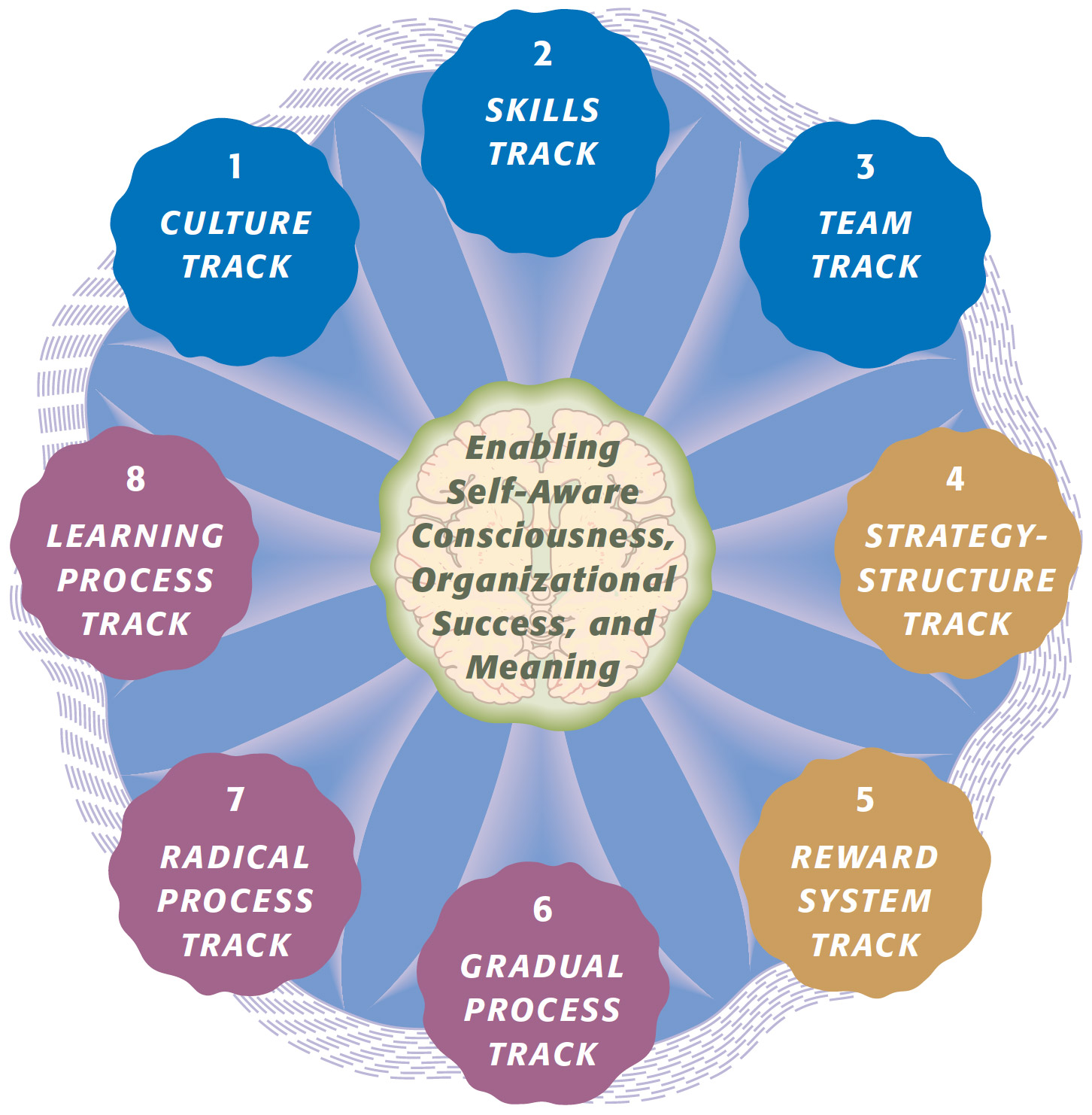RALPH KILMANN’S REVOLUTIONARY BOOK ON THE EIGHT TRACKS FOR CREATING QUANTUM ORGANIZATIONS
Further down on this page, you can order Quantum Organizations directly from Amazon or Barnes & Noble, as well as review the detailed Table of Contents. But first read the many insightful ENDORSEMENTS for Kilmann’s Quantum Organizations. Then, directly below, you’ll find an inspiring perspective about the challenge of transformation in the new millennium.

A Review of Quantum Organizations:
Harvard Business School
Working Knowledge
“Don’t be stumped by all the references to quantum physics, relativity theory, cosmology, and neuroscience. Ralph Kilmann, a professor of management at the University of Pittsburgh, has a new way of helping managers think about self-transformation in their organizations. He argues that over the past century, organizations have done well using narrow specialization. But problems are now so complex and interconnected that the usual ways of coping, via extreme specialization, no longer suffice. His model calls for “seeing, thinking, and behaving with new holistic categories.” He not only makes very abstract ideas accessible to managers; he also demonstrates how organizations can implement these ideas to their fullest extent.”
July 23, 2001
FROM THE PREFACE:
A NEW PARADIGM FOR
QUANTUM ORGANIZATIONS
During the past century, the great success of organizations in the Western world was achieved through extreme specialization. Experts could resolve well-structured problems within well-defined fields—and put a man on the moon.
But the immense success of specialization has also resulted in a daunting progression of unintended consequences: Specialization has created widespread fragmentation—in people, organizations, and nations. Problems no longer fit within strict scientific specialties or traditional management functions but, instead, exist in between the specialties, fields, disciplines, and categories that evolved from prior centuries. Complex problems now swirl across—and encircle—the entire globe. The new millennium finds itself deeply entangled with the intermingling of all social, economic, political, biological, psychological, spiritual, and environmental problems.
What were once simple problems that could be solved by extreme specialization have become complex problems that challenge fragmented categories. To succeed in the new millennium, accordingly, requires holistic categories that will enable members and their organizations to (1) clearly see the flowing interconnections surrounding the globe, (2) consciously think about interconnected problems in comprehensive ways, and (3) purposely behave in a manner that stimulates the meaningfulness and coevolution of life and nature throughout the world and the expanding universe. Seeing, thinking, and behaving with new—holistic—categories requires a mental revolution in self-aware consciousness.
All members and their organizations are intimately interconnected within the global ecosystem. Their success now depends on whether they are active participants in the holistic movement that is progressing toward self-aware consciousness. They can choose to ignore it and simply continue down the narrow course of specialization—with blinders in place. Or they can choose to embrace it—and transform the way they see, think, and behave. But one thing has become especially clear: Denying, ignoring, or avoiding what is already happening in between scientific spheres, management functions, and most other categories is not fully engaging with reality. We live in an interconnected world yet suffer from acute fragmentation.
The distinctive purpose of my book is twofold: (1) to provide a deep understanding of a new paradigm with self-aware consciousness at center stage and (2) to offer a completely integrated program of eight tracks for effectively—and compassionately—accelerating self-aware consciousness in complex systems. By applying these insights and tracks, it is possible to create quantum organizations and thereby achieve success, happiness, and meaning.
Although I have included many examples about various aspects of self-transformation and quantum organizations in my book, I cannot point to any organization that incorporates all attributes of a quantum organization. Actually, my hope is that this book will challenge people to examine their own paradigms and those of their organizations. As people achieve both self-aware consciousness and self-transformation, they will create living proof of quantum organizations. At some point, we can then determine if holistic categories with organized action can effectively heal the interconnected problems that encircle our globe.
Table of Contents
TABLE OF CONTENTS
LIST OF 107 FULL-COLOR ILLUSTRATIONS
PREFACE
CHAPTER 0: THE ULTIMATE ENCOUNTER
WHAT WOULD YOU DO DIFFERENTLY?
A CHALLENGE TO THE READER
CHAPTER 1: TWO DUELING PARADIGMS
THE OLD PARADIGM
Two Dominating Patriarchs
Seven Essential Categories in the Old Paradigm
THE NEW PARADIGM
Discovering the Quantum Nature of Light
Discovering the Absolute Speed of Light
The Realization of a Relativistic Universe
Superstrings as the Substance of Spacetime
Rejecting the Separation of Mind and Matter
Bringing Consciousness into the Cosmos
Journeying into Consciousness
The Evolution of Multiple Universes
The Relevance of Quantum Mechanics
Seven Essential Categories in the New Paradigm
THE CHALLENGE OF TRANSFORMATION
CHAPTER 2: THE NEW ORGANIZATION
PICTURING THE NEW PARADIGM
PARADIGMS FOR ORGANIZATIONS
The Newtonian Organization
The Quantum Organization
AN OVERVIEW OF SELF-TRANSFORMATION
Summarizing the Eight Tracks
Sequencing the Eight Tracks
SUMMARIZING THE STAGES OF TRANSFORMATION
CHAPTER 3: QUANTUM INFRASTRUCTURES
THE CULTURE TRACK
Diagnosing Cultural Norms
The Case of American Gas & Electric
Step One: Surfacing Actual Norms
Step Two: Establishing Desired Norms
Step Three: Identifying Culture-Gaps
Step Four: Closing Culture-Gaps
THE SKILLS TRACK
Managing Complex Problems
Managing Implicit Assumptions
THE TEAM TRACK
THE FIRST THREE TRACKS
CHAPTER 4: FORMAL SYSTEMS
THE PROBLEM MANAGEMENT ORGANIZATION (PMO)
Mobilizing the Shadow Track
Mobilizing the Strategy-Structure Track
Mobilizing the Reward System Track
ALIGNING AND DEPLOYING ALL SYSTEMS
THE STRATEGY-STRUCTURE TRACK
Formulating and Deploying Strategic Architecture
Designing and Deploying Structural Forms
THE REWARD SYSTEM TRACK
Motivation, Rewards, and Performance
Developing and Deploying Reward Practices
THE MIDDLE TWO TRACKS
CHAPTER 5: PROCESS MANAGEMENT
THE GRADUAL PROCESS TRACK
Describing Value-Added Processes
Controlling Value-Added Processes
Improving Value-Added Processes
THE RADICAL PROCESS TRACK
Distinguishing Gradual and Radical Improvement
Redesigning Structure for Radical Improvement
Using Economic Criteria for Process Management
Mobilizing PMOs for Radical Improvement
THE LEARNING PROCESS TRACK
THE LAST THREE TRACKS
CHAPTER 6: CRITICAL SUCCESS FACTORS
ENABLING SELF-AWARE CONSCIOUSNESS
Exploring Ego Energy and Ego-Defining Processes
Exploring Spirit and Spiritual Enlightenment
ENABLING ORGANIZATIONAL SUCCESS
ENABLING PERSONAL MEANING
CONCLUDING REMARKS
BIBLIOGRAPHY
ABOUT THE AUTHOR
INDEX
WHY READ KILMANN’S BOOK ON
QUANTUM ORGANIZATIONS?
If you or your clients are eager to learn how to transform a sluggish Newtonian organization into a vibrant quantum organization, this book will inspire you to discover the sequence of eight tracks that lead to long-term organizational success and personal meaning: culture track, skills track, team track, strategy-structure track, reward systems track, and the three process tracks for gradually and radically improving key business processes—while speeding up the process of learning itself. Because these change initiatives are so vital to understand (especially during times of increasingly complex challenges), this revolutionary book is especially relevant to these
OCCUPATIONAL IDENTITIES:
Purchase
Quantum Organizations
You can order Quantum Organizations (370 pages) directly from Amazon or Barnes & Noble.
Quantum Transformation:
Take this course to learn how to
create—and maintain—a true
Quantum Organization
A grand overview of the eight tracks to long-term success, so members can transform an old Newtonian organization into an empowered, highly conscious, quantum organization.




















